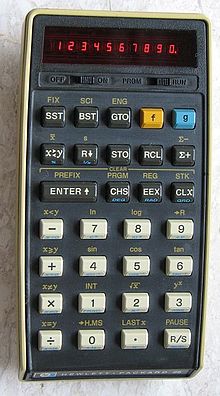HP-25
 | |
| Calculator | |
|---|---|
| Entry mode | RPN |
The HP-25 was a hand-held programmable scientific/engineering calculator made by Hewlett-Packard between 1975 and 1978. The HP-25 was introduced as a cheaper (US$195[1] MSRP) alternative to the ground-breaking HP-65.
To reduce cost, the HP-25 omitted the HP-65's magnetic card reader, so it could only be programmed using the keyboard. After switching off, the program was lost and had to be typed in again. The model HP-25C, introduced in 1976, addressed that shortcoming through the first use of battery-backed CMOS memory in a calculator, termed continuous memory by HP.
Like all early HP calculators, the 25 used the Reverse Polish Notation (RPN) for entering calculations, working on a four-level stack (x,y,z,t). Nearly all buttons had two alternative functions, accessed by a blue and yellow prefix key. A small sliding switch was used to change between "run" and "program" mode. The HP-25 used a 10-digit red LED display and was the first calculator to introduce the "engineering" display option, a denormalized mantissa/exponent format where the exponent is always a multiple of 3 to match the common SI prefixes, e.g. mega, kilo, milli, micro, nano.
The HP-25 had memory space for up to 49 program steps. It was the first HP calculator which used fully merged keycodes (storing prefix key and function key together in one program location) to save memory space. Additionally there were eight storage registers and specialized scientific and statistical functions. The owner's manual came with 161 pages in four colors and contained many mathematical, scientific, navigational and financial programming examples.
The HP-25 was about 25% smaller than the HP-65. One unusual thing about the ergonomics is that the key faces have the profile of a trapezoid. The HP-25 was a competitor to the TI-58 and TI-58C calculators offered by Texas Instruments. Looking strictly at the functionality and capacity, the TI-57 was more of an equal competitor. It lacked a few of the HP-25's functions, but had some other advantages.
One notable deficiency of the HP-25/25C was the lack of a subroutine capability. The competing TI-58 and even the earlier SR-56 had subroutines. Although 49 fully merged keycodes were roughly equivalent to the unmerged 100 steps of the SR-56; by the time the TI-58 arrived with 480 steps, subroutines, DSZ loops, etc., the HP-25/25C had serious competition. HP would go on to introduce the HP-29C/19C calculators with 99 merged steps, labels, and subroutines. And TI would introduce a TI-58C with continuous memory.
See also
External links
- The Museum of HP Calculators' article on the HP-25
- 1975 HP Calculator Christmas Guide
- HP-25 and HP-25C pictures on MyCalcDB (database about 1970s and 1980s pocket calculators)
- HP-25 hardware details
- HP-25 Brochure from Hewlett-Packard
- Hewlett-Packard Journal, November 1975
Notes
- ^ US$195 in 1975 ≈ US$770 in 2009 (see The Inflation Calculator)
